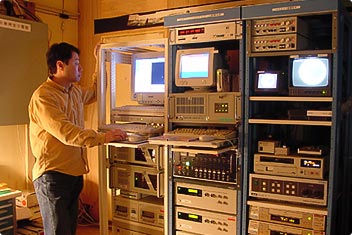From the ground to the upper atmosphere
It seems like such a spectacle! Let me ask you: does data collected at the poles arrive quickly in Tokyo ?

© NIPR
No. Until recently, the Antarctic observation vessel Shirase carried with it an enormous amount of data every time it returned to Japan. But Shirase comes home only once a year -- at the beginning of April. Starting this year, however, by using the Intelsat satellite, Syowa Station and the institute are connected all the time. It will soon be possible to take data from hundreds of aurora images captured every night and send it to Japan the very next day.
What does the data tell us ?

© NIPR
We are still gathering data, since it has only been a few years since the start of regular observation, but some positive results have already been obtained. For example, by analyzing minute details in the auroral light, the temperature and wind speed at the aurora's altitude can be estimated. Although most changes in temperature are caused by the changes of altitude, unexplained phenomena have been found. I believe that the atmosphere is regionally heated by some sort of energy that accompanies the auroral activity and causes the temperature to rise. In this way, we are speculating on these phenomena from the measurement data. We hope that as we accumulate further data, things will be become clearer.
Are such changes in the upper atmosphere related to changes on the earth, such as environmental pollution ?
Direct relationships between the atmosphere near the surface of the earth and that of the upper atmosphere are not clear, since they are so far apart. However, I believe that there is some sort of connection. There are possibilities that the amount of water vapor that flows from the troposphere into the upper layer of the atmosphere has changed due to global warming, or it could be possible that nitrogen oxide produced by the auroral activity influences the composition of the lower layers of atmosphere. There is also a wave phenomenon in which a density change in the lower layer of atmosphere propagates to the upper atmosphere as a wave. It has also been observed that waves in the atmosphere that were thought to originate in the polar regions where the aurora appears travel to Japan's upper sky like tsunami (seismic sea waves). In that sense, various phenomena in the earth's atmosphere have influence in every direction.

